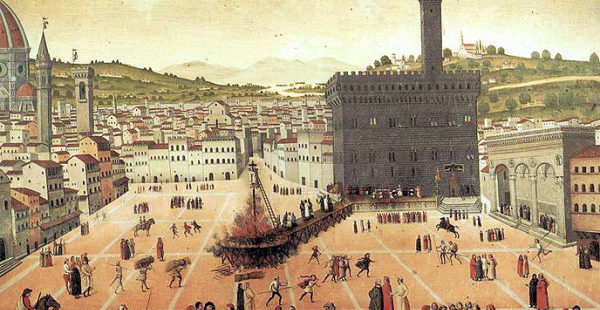
Three Lessons from Girolamo Savonarola
He was a stern, solemn figure. He almost defeated the Renaissance. He advocated reformation years before Martin Luther. His name was Girolamo Savonarola, and most have never heard his story.
Today Florence is a beautiful Tuscan city, flooded with tourists and filled with museums. Six hundred years ago it was the home of the Renaissance, the ‘rebirth’ of ancient culture and learning in medieval Europe.
The Middle Ages were dominated by the Roman Catholic Church, but two dates mark the rise of new ideologies. An art competition in 1401 marked the beginning of the Renaissance. Luther’s 95 theses in 1517 sparked the Reformation. The Reformation advanced Protestantism and emphasized a return to the Bible. The Renaissance promoted secular humanism, modelled by ancient Greek and Roman culture.
1) The Devil Uses the Same Arsenal
Savonarola entered the monastery around the age of twenty-three. Eventually he ended up in Florence, teaching and worshipping at the Convent of San Marco. His preaching attracted large crowds; eventually he began preaching in the Duomo, or great cathedral of the city. It was here, in 1401, that the craftsmen Ghiberti and Brunelleschi sparked the Renaissance in their race to create the finest bronze doors for the Baptistry.
Captivated by the impressive culture, tastes, and arts of ancient Greece and Rome, Renaissance thinkers began to recreate this culture in their own stunning artwork. The Roman Catholic Church remained important in Florence, but religion was modified by culture. Famous – and infamous – art was created. The sacred was mixed with the scandalous.
The Devil still uses the same tools. From the culture of Greece and Rome, to the streets of Florence, to modern America, secular humanism remains powerful. Today, it is the dominant philosophy of the West – a philosophy in which God can play a part (or not), but He has little practical effect on daily life.
2) Even Great Men Have Their Mistakes
Savonarola lived in a place of great vanity and worldliness, and he bitterly condemned such lifestyles in his preaching. Something remarkable was happening in Florence: the city which had birthed the Renaissance began to listen to the Word of God. Crowds continued to flock to the Cathedral, and Savonarola’s followers organized themselves into a political party. Savonarola himself was barred from government office because of his role as a friar, but his sermons guided public opinion.
Savonarola’s government was remarkably benign. A new constitution gave the lower classes more political power, capital punishment was restricted, and every citizen was given the right to vote.
Savonarola, however, was also a man of his time – one who could not imagine the separation of church and state. He preached against the scandals and vices of Renaissance Florence, and his political party worked to outlaw vice. While some of this may have been necessary, it was also highly restrictive, as gangs of youth patrolled the streets to ensure that citizens followed the moral rules of the new government.
Savonarola’s supporters even organized a ‘Bonfire of the vanities’ in which citizens were encouraged to bring their secular art, books, and cosmetics to the town square to burn in a bonfire. This was nothing new – bonfires of disagreeable books were somewhat common during that time – but this may not have been the wisest move. For all his successes, Savonarola still failed to recognize that true religion cannot be mandated.
3) Secular Humanism is the Most Intolerant Tolerance
Savonarola made enemies, too. The former power brokers of Florence resented the new preacher. As Savonarola excoriated secularism from the pulpit, he also excoriated aspects of the Roman Catholic Church which he found unbiblical. It was a golden moment for the papacy. One of their own was pointing out their faults, and if the Church moved to remedy the weaknesses, perhaps the Reformation would not break out in twenty years. But the Church did no such thing. Irritated by the pious friar, Pope Alexander VI excommunicated Savonarola.
Eventually the crowds turned against him. Savonarola was arrested, imprisoned, and tortured. Then, condemned to die, he was taken to the town square of Florence, hanged, and burnt.
Luther is rightly famous for igniting the Reformation. Savonarola, known as a ‘pre-reformer,’ led a frontal assault on secular humanism. Luther lived. Savonarola died. Secular Humanism – which was willing to tolerate even the scandals of Greek and Roman culture – had no place for a preacher of Scripture.
And so it is today. Secular humanism will tolerate anything: any art form, any orientation, any lifestyle, any spirituality, any belief system. But one thing it will not tolerate: those who intend to believe and obey the Bible.
Conclusion
Despite his flaws, I appreciate him. Here is a man who stood against secular humanism at the beginning. Even today, many people appreciate Luther, but few appreciate Savonarola. He is viewed in Florence as a kill-joy, a man who wouldn’t tolerate a little fun. Perhaps it is right to criticize him. But Savonarola was fighting the same battle that modern Christians must fight. We live in one of the most secular, humanistic cultures in the history of the world. Perhaps Savonarola understood the spiritual battle better than we do.
Luther himself said it best. “Where Christ is, there He always goes against the flow.”



